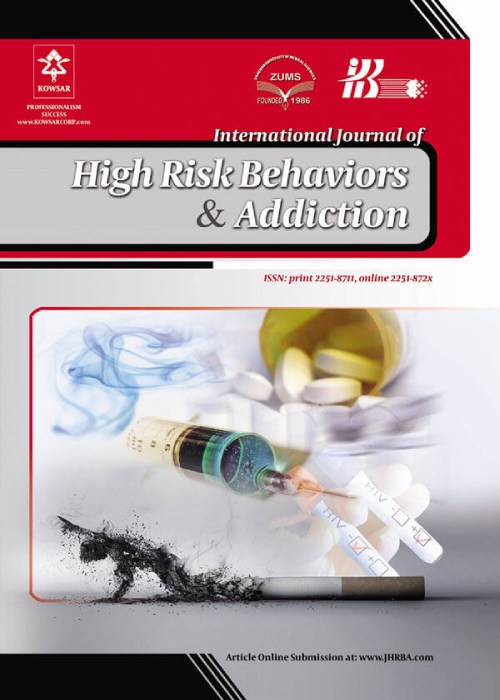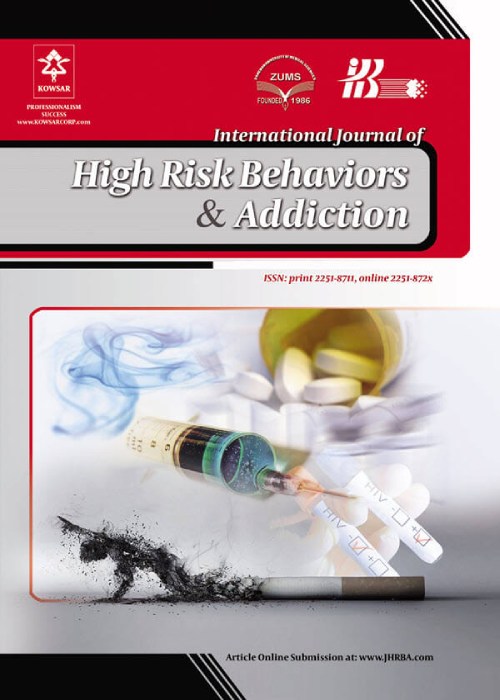فهرست مطالب

International Journal of High Risk Behaviors and Addiction
Volume:12 Issue: 1, Mar 2023
- تاریخ انتشار: 1402/01/14
- تعداد عناوین: 7
-
-
Page 1
Context:
This research aimed to determine the protective and risk factors of high-risk sexual behaviors.
MethodsStudies assessing high-risk sexual behaviors from 2000 to 2021 were reviewed. We retrieved 743 articles from SAGE, Wiley, Science Direct, Taylor & Francis Group, SID, and Google Scholar. Two independent reviewers extracted data using a tool developed by the review team. Forty-five articles were included in the final analysis.
ResultsReligion, parental care, education, health literacy, and active participation in work activities act as protective factors. On the other hand, negative sexual self-concept, parental divorce, weak religious beliefs, and escaping social rejection make people vulnerable to risky behaviors.
ConclusionsThe joint actions of families, schools, and society can effectively deal with such behaviors.
Keywords: Systematic Review, Youth, Sexual Behavior -
Page 2Background
Midlife is a transitional period in the lives of men, with middle-agedmenexperiencing various changes thatmaylead to an impairment of their quality of life (QOL). Middle-aged men tend to rely on alcohol to overcome stress due to various changes they undergo.
ObjectivesThis study aimed to determine the association between alcohol consumption andQOLin middle-agedmenand identify the factors affecting their QOL.
Materials and MethodsThis paper presents a secondary data analysis of rawdata from the 2019 Korea National Health and Nutrition Examination Survey conducted by the Korea Disease Control and Prevention Agency. This study was conducted on men aged 40 - 64 consuming alcohol over the past 12 months. A total of 992 participants was selected for analysis. The research objects were alcohol consumption and QOL, measured using the Alcohol Use Disorders Identification Test-Consumption (AUDIT-C) and European QOL-5 Dimensions, respectively. Data analysis was performed by SPSS/WIN v25.0 using descriptive statistics, t-test, one-way ANOVA, and hierarchical multiple regression analysis. The significance level was set at 0.05.
ResultsAmong the general characteristics, significant differences in QOL were observed by age, education, marital status, economic activity, and income. Among the lifestyle and mental health variables, significant differences in QOL were observed by sleep status, exercise, smoking, subjective health, happiness, stress, andsuicidal ideation. The factors affectingQOLwere suicidal ideation, sleep status, income, economic activity, subjective health, and stress in order of importance. The regression analysis revealed that alcohol consumption did not affect QOL.
ConclusionsQuality of life is influenced by various aspects of life, such as the psychological dimension (e.g., stress and suicidal ideation), physical dimension (e.g., sleep status and subjective health), and social dimension (e.g., income and economic activity). Therefore, developing and implementing integrated interventions considering these multidimensional factors is necessary.
Keywords: Alcohol Drinking, Binge Drinking, Middle-aged, Quality of Life -
Page 3Background
The integrated motivational-volitional (IMV) model is the second theory based on the ideation-to-action framework.
ObjectivesThe current study aimed to investigate the motivational phase of this model in the Iranian population. In this study, threat-to-self moderators are included cognitive emotion regulation strategies. Also, thwarted belongingness and perceived burdensomeness are considered motivational moderators.
Materials and MethodsAtotal of 405 participants (68.6% female; meanage: 22.7 years) filled out several self-report questionnaires, including the Defeat Scale, Entrapment Scale, Beck Scale for Suicidal Ideation, Cognitive Emotion Regulation Questionnaire-short, Interpersonal Needs Questionnaire-15. To assess the IMV model, structural equation modeling with the interaction of latent variables was performed.
ResultsThe results indicated that the overall model’s fit was poor. Although the model explained 70% and 61% of the variance in entrapment and suicidal ideation, respectively, the pathway between entrapment and suicidal ideation was not statistically significant. The findings demonstrated that the most effective predictors of suicidal ideation were perceived burdensomeness and thwarted belongingness.
ConclusionsThe results add to our knowledge of what constructs are more critical in the emergence of suicidal ideation. It is hoped that the study findings will lead to a greater interest in this field of research in the future.
Keywords: Suicide, Suicidal Ideation, Structural Equation Modeling -
Page 4Background
Increasing access to various forms of pornography since the advent of the Internet has provided a new context for couples’ sexual experiences, but the possibility of adverse effects of pornography on couples’ romantic relationships is a concern.
ObjectivesThe aim of this study was to compare sexual desire and marital satisfaction in two groups of married women with and without a history of pornography use in Rafsanjan, Iran.
Materials and MethodsThis descriptive study was performed on 254 women with children covered by comprehensive health centers in Rafsanjan by convenience sampling in 2020. Data collection tools included demographic characteristics form, Enrich Marital Satisfaction Questionnaire, Hurlbert index of sexual desire and sexual pornography use questionnaire. Data were analyzed by chisquare, two independent samples, and multivariate analysis of covariance in SPSS software version 21. the statistical significance level of p-values considered at 0.05.
ResultsThere was a positive and significant relationship between sexual desire and the use of pornography (P = 0.043). The mean score of marital satisfaction in the group of pornography users women was lower than the nonusers group, but this relationship was not statistically significant. Of the nine components of marital satisfaction, there was a statistically significant difference between the two groups only in the component of financial management (P = 0.037). There was no statistically significant relationship between demographic characteristics and use of pornography (P > 0.05).
ConclusionsIt seems that the use of pornography in married women is related to sexual desire, but in the present study, no relationship was found between the use of pornography and marital satisfaction. More studies required to reveal the relationship between pornography use on sexual features of women and their partners.
Keywords: Pornography, Sexual Desire, Marital Satisfaction, Women, Iran -
Page 5Background
Smoking is a form of risky behavior that often starts in adolescence and is continued into adulthood. There has also been an increase in the use of vaping among adolescents. Adolescents who smoke have a double the risk of having depression symptoms compared to those who don’t smoke.
ObjectivesThis study aimed to investigate smoking and vaping behaviors and the experience of depressive symptomsamonghigh school students in Jakarta, Indonesia.
Materials and MethodsThis cross-sectional study used the Youth Risk Behavior Surveillance (YRBS) 2017 questionnaire. Participants included 258 students aged between 10 and 19, randomly chosen from three types of senior high schools in Jakarta.
ResultsWe found that 21.5% of students frequently smoked in the last 30 days, and 8.1% vaped repeatedly. However, 70.5% of them tried vaping. Moreover, within the last 12 months, approximately 8.5% of the students attempted suicide at least once. Also, 32.9% of them felt sad and hopeless for two weeks. Interestingly, we found that 54.1% of the students who felt sad were frequent smokers, and 43.5% were regular vapers.
ConclusionsThis study showed that risky behaviors like smoking and vaping were prevalentamongsenior high school students in Jakarta. Students who smoked or vaped exhibited depressive symptoms. Therefore, smoking and vaping could affect mental health in adolescence.
Keywords: Smoking, Vaping, Depressive Symptoms, Student, Youth Risky Behaviors -
Page 6Background
Despite the increased use of methamphetamine, little is known about its adverse effects in developing countries.
ObjectivesThis study aimed to investigate the adverse events of methamphetamine use in Iran.
Materials and MethodsA total of 29 subjects who were recruited in the Iranian Mental Health Survey (IranMHS, a 2011 national household survey) and used methamphetamine more than five times in the past year enrolled in this case series study. Six years after the index interview, eligible participants were contacted to assess their frequency of methamphetamine use in the past year, the incidence of adverse events, and utilization of substance use treatment services.
ResultsOne death was recorded among 29 eligible cases. Of the 13 completed interviews (all male), the majority (n = 10) reported abstinence, and 2 reduced their methamphetamine use in the past year. More than two-thirds (n = 9) of participants experienced at least 1 adverse event. Incarceration and violent behavior were the mostcommonadverse events. Of the 10 individuals with methamphetamine use disorder, none received specific health care treatment.
ConclusionsThe study participants experienced a high rate of adverse events, and none of those with methamphetamine use disorder received specific treatment. Further prospective studies are needed to investigate the causal relationship between methamphetamine use and adverse events.
Keywords: Addiction, Substance Use Disorders, Methamphetamine, Prognosis


